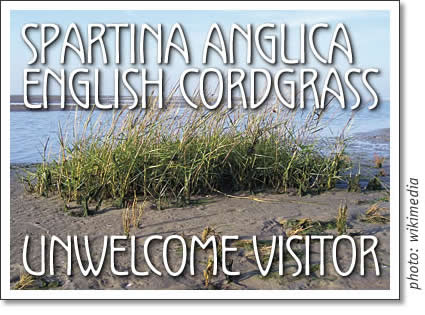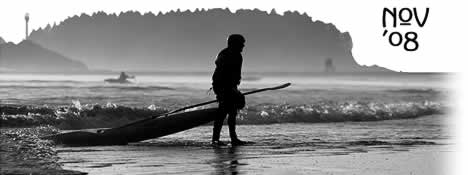
Spartina Anglica - English Cordgrass, unwelcome visitor
by Josie Osborne, Tofino
Spartina - another invasive plant to be aware of on the West Coast of Vancouver Island.

Say the words Scotch broom, English ivy, or Himalayan blackberry to the right people and you will hear a resounding groan: many people on the West Coast are familiar with these invasive and problematic species. In October 2008, I wrote about a plant that might not be considered invasive yet, but probably ought to be. Gunnera, the large Chilean plant (a.k.a. Giant Rhubarb) that can be found in yards and roadsides throughout Tofino and Ucluelet has been declared invasive in New Zealand and Ireland and could soon be a problem on the West Coast of Vancouver Island, if it isn't already. Spartina, or cordgrass, is another potential invader to be aware of.Spartina is a genus of perennial grass containing about 14 species native mostly to the coasts of the Atlantic Ocean. Cordgrasses are tolerant of salt and anoxic (oxygen deprived) sediments, so they are commonly found in fresh and salt water wetlands and estuaries, tidal flats, and salt marshes. Cordgrasses can reproduce sexually through seeds, or asexually by the spread of their dense rhizomes (roots). As cordgrass spreads, it forms a dense baffle of stems and roots, which slows water movement and increases the deposition of fine sediments carried in the water. In effect, cordgrass helps create its own soil. This causes a rise in sediment level, making the area more terrestrial than aquatic, and creating an opportunity for less salt tolerant plant species to move in. This natural succession of species is important in creating the salt marshes that dot the eastern North American coastline. These cordgrass marshes provide habitat for wide variety of species, from crabs, mussels and other estuarine invertebrates to marsh birds that nest and forage in the marsh.
As early as the 1800s, humans noticed the potential for cordgrass to stabilize coastlines and waterways, and we began to introduce species of cordgrass in new areas. Spartina alterniflora (smooth cordgrass), native to the east coast of North America, was introduced to the United Kingdom prior to 1870. The UK already had its own native species of cordgrass, Spartina maritima, or short cordgrass, and the two species grow in similar habitats. Presto - smooth cordgrass and short cordgrass began to interbreed, and a new species was born. English cordgrass is a vigorous and aggressive hybrid that is able to reproduce sexually and asexually, so it was given the unique scientific name Spartina anglica. In fact, English cordgrass is so good at spreading and stabilizing soft sediments, it was purposely transplanted across England, Europe, China and eastern North America. Astute readers will know where this story is going... English cordgrass is not a species that has evolved over generations and generations to co-exist with other plants and animals. Its aggressive growth displaces native species, leaving a dense monoculture that is far less valuable to wildlife than a natural marsh with diverse plant species. Where English cordgrass has been introduced to open mudflats, it quickly grows and covers open sediments that once supported worms, shrimp, and clams which in turn supported birds and even whales.
Closer to home, English cordgrass was intentionally introduced in 1961 to Puget Sound for dyke stabilization and to provide forage for cattle. By the mid 1970s, it covered a 2.7 hectare area (almost 22 Olympic swimming pools). In 1997, it had spread to over 70 sites, affecting 3300 ha. of marine intertidal area (about 400 ha. of solid habitat). But it's not just this aggressive hybrid that's created a problem in the western US. Smooth cordgrass (Spartina alterniflora) was accidentally introduced on North America's west coast in the early 1900s and by 2002 it occupied 5,500 hectares of Willapa Bay in southern Washington and had raised the bay floor up 30 cm, impacting migratory shorebird habitat, salmon rearing habitat and oyster aquaculture businesses. Millions of dollars and countless hours of effort are being spent in Willapa Bay to remove smooth cordgrass.
The best way to remove cordgrasses is within the first year or so of its arrival, before it has had a chance to begin spreading. It can be removed by hand until a dense patch of individual cordgrass plants (called a clone since they are formed by asexually spreading roots) reaches about one meter across - after that, excavators are required. Larger patches of cordgrass have been treated in the US and the UK with chemicals whose names are hard to pronounce.
That I know of, neither English cordgrass or smooth cordgrass have been seen in Clayoquot or Barkley Sounds. It is entirely possible that viable seeds can reach our shores from Puget Sound or western Washington, and with so many remote beaches and estuaries and isolated areas of the Tofino Mudflats, young Spartina plants might not be spotted until they've reached well over the one meter clone size. Our best defenses are awareness and keen eyes. Do not plant Spartina on your property! Learn how to identify Spartina, and if you think you have spotted it, report it to the Raincoast Education Society at res@island.net.
Josie Osborne is a Tofino-based naturalist and Executive Director of the Raincoast Education Society. She can be reached at res@island.net or (250) 725-2560. The man who discovered Spartina anglica in British Columbia (August 2003 on Roberts Bank in the Fraser River estuary) is Gary Williams, who lives in Port Coquitlam, BC. In conjunction with Vancouver Aquarium and Ducks Unlimited, Gary and his colleague Sarah Anning will be in Tofino on November 18th 2008 for a Spartina workshop from 9:00 to 11:30 am at the Clayoquot Field Station. To join this free classroom and field training session, please rsvp to the Raincoast Education Society at res@island.net or 250.725-2560.
Tofino Time Magazine November 2008
- Tofino in November
- Tofino Surf Tips: The Duck Dive and the Turtle Roll
- Tofino tides: Tide table for Tofino November 2008
- Concerts in Tofino: November
- Clayoquot Sound's Deep Water Oysters
- Tofino artist Linda Skalenda
- Tofino artist Mark Hobson
- Tofino book launch: The Oyster that looked at the Sky
- Tofino Oyster Festival: November 20-22, 2008
- Builders of the Pacific Coast - A new book by Lloyd Kahn
- Tofino storms: Happy thoughts on lousy weather
- Tofino history: Voices from the Sound
- Spartina Anglica - English Cordgrass, Unwelcome Visitor
- Tofino Gardening in November
- Tofino Horoscope for November 2008
- Events in Tofino: November 2008
- Community Directory: Goods & Services in Tofino
tofino | tofino time | activities | accommodation | events | directory
maps | travel | food | art & artists | photos | horoscope | tides
search | magazine | issues | articles | advertising | contact us
hosted in tofino by tofino.net & studio tofino
© 2002-2014 copyright Tofino Time Magazine in Tofino Canada

Spartina anglica, English cordgrass, is a potential problem plant on the West Coast of Vancouver Island and the beaches in Tofino.
